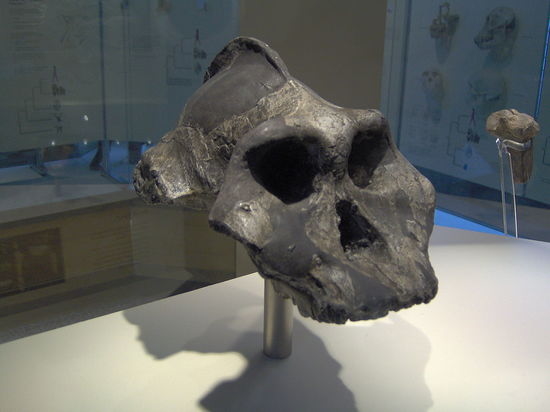What Was the Black Skull?
Anthropologists know little about Paranthropus aethiopicus and they don’t all agree on the 2.5-million-year-old species’ place in the human family tree
![]()

Scientists disagree on whether the 2.5-million-year-old Black Skull should be called Paranthropus aethiopicus or Australopithecus aethiopicus. Image: Nrkpan/Wikicommons
Paleoanthropologists Alan Walker and Richard Leakey unearthed the Black Skull (KNM-WT 17000) in 1985 at the site of West Turkana, Kenya. The 2.5-million-year-old skull was darkened by manganese minerals in the soil where it was buried. Complete except for the crowns of its teeth, the skull appeared to match several isolated jaws and teeth previously found in East Africa. The fossils belong to the species Paranthropus aethiopicus—or Australopithecus aethiopicus, depending on who you ask. The species highlights the trouble of identifying parallel evolution, when species independently evolve similar traits, in the hominid fossil record.
The features of the Black Skull, and the related teeth and jaws, are striking. The species had massive molars and premolars, thick jaw bones and a large sagittal crest—a ridge of bone running lengthwise down the back of the skull where chewing muscles attach. All of these features align the species with the powerful masticator Paranthropus boisei, which lived in East Africa 2.3 million to 1.2 million years ago, and Paranthropus robustus, which lived in South Africa 1.8 million to 1.2 million years ago. Because of the Black Skull’s greater age, some anthropologists think it’s the ancestor of the younger P. boisei and P. robustus, and call the species Paranthropus aethiopicus. All three Paranthropus species are thought to form a dead-end side branch on the human family tree.
That’s one way to interpret the Black Skull. But other features complicate the picture.
In some ways, the Black Skull wasn’t at all like the other Paranthropus species and was instead more similar to the older, more primitive Australopithecus afarensis: It had a flat skull base, a shallow jaw joint, a protruding face and a small brain (410 cubic centimeters). In contrast, P. boisei and P. robustus had an angled skull base, a deep jaw joint, a flat face and a somewhat larger brain (500 to 545 cc)—all traits that they shared in common with early Homo. If P. boisei and P. robustus evolved from the more primitive P. aethiopicus, it means they share features with early Homo due to parallel evolution–that is, both lineages independently evolved similar cranial characteristics.
In the 1990s, Randall Skelton of the University of Montana and Henry McHenry of the University of California, Davis (one of my graduate school professors) came to a different conclusion regarding the similarities between Homo and Paranthropus. They suggested (PDF) that the two lineages actually inherited their shared features from a common ancestor, perhaps a species like South Africa’s Australopithecus africanus. In their opinion, P. aethiopicus was too primitive to be the ancestor. And in fact, the pair argued that parallel evolution, not common ancestry, explained all of the resemblances between the Black Skull and P. boisei and P. robustus; all three species must have had similar diets and therefore evolved similar chewing power. In this scenario, the Black Skull was an earlier offshoot of the Australopithecus lineage that left behind no descendants and should be called Australopithecus aethiopicus.
So, how did anthropologists come up with such different opinions about the Black Skull’s place in the human family? The answer comes down to how researchers construct their family trees, or phylogenies. The trees are made through a cladistic analysis, in which researchers, with the help of computers, group species based on the overall number of shared traits inherited through common ancestors. Different trees can arise for a number of reasons, such as how traits are interpreted and defined. For example, should large molars, thick jaws and a big sagittal crest count as three traits or one large trait complex related to chewing?
Over the years, anthropologists have constructed numerous trees that support both arguments, although the P. aethiopicus scenario appears to be the most favored as that species name is most commonly used. Regardless, the case of the Black Skull reminds us that sometimes looks can be deceiving, especially in the fossil record.
/https://tf-cmsv2-smithsonianmag-media.s3.amazonaws.com/accounts/headshot/science-erin-wyman-240.jpg)
/https://tf-cmsv2-smithsonianmag-media.s3.amazonaws.com/accounts/headshot/science-erin-wyman-240.jpg)